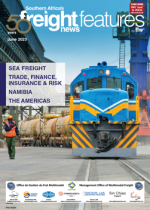One of Namibia’s transport stalwarts, Andre van der Walt, says the country’s cross-border road freight industry has more than the necessary know-how and robust ability to meet demand when volumes begin to pick up at the Port of Wa lv i s Bay.The port’s 750 000-TEU capacity is currently 25% underutilised, but when Terminal Investment Limited (TIL) assumes control of the container terminal later this year, volumes are expected to at least double.This was confirmed by Taná Pesat, corporate communications manager of Namibia’s ports authority, Namport.“TIL’s presence at the port is going to make a difference and bring in the kind of volume we want. We just need to make sure that the entire supply-chain industry is ready for the loads once they increase.”The former owner of A van der Walt Transport says there’s no question that this will happen.“TIL is going to make a major difference, no doubt about that,” Van der Walt says of the Mediterranean Shipping Company (MSC) subsidiary.“MSC won’t get involved unless they see the potential for substantial volume growth, and the only real reason why they’re getting involved is because of a projected increase in transit cargo through Namibia to the Copperbelt in Zambia and the DRC (Democratic Republic of the Congo).“When the sea freight comes,” Van der Walt says, “so will the transport industry – in much larger numbers.“And the question isn’t whether the trucking industry will be able to absorb an increase in cargo. Rather, it’s a case of whether certain stretches of road will be ready by then.”One such section is the B2 link between Usakos and Karibib, a shoulderless stretch in desperate need of resurfacing and widening.“We believe there’s funding and that it’s high on the government’s agenda, but it’s anyone’s guess when it will be upgraded,” Van der Walt said.Oshoveli Hiveluah, divisional manager for Network Planning at Roads Authority Namibia, confirmed as much at a Logistics Hub Forum in March, without giving any clarity as to when work on the B2 can be expected.Looking further north towards the Copperbelt, Van der Walt says the road freight industry will most likely never support plans to establish an intermodal station at Grootfontein.This plan by TransNamib to move loads from road to rail still requires significant upgrading work on the line from Walvis to Kransberg and further beyond.Inter-modality costs will also place an additional burden on the country’s already strained fiscus. As for routes across the border once in Zambia, there’s not much Namibian transporters can do except hope that something will be done, Van der Walt says.“At the moment we prefer to cross at Katima Mulilo, going via Sesheke to Mongu up north, then east to Lusaka. Going further into the panhandle is an option, especially because of the bridge across the Zambezi.“But that way takes two border crossings, at Ngoma and Kazungula, and although it’s about 200 kilometres shorter than the Sesheke road, Botswana charges heavy tariffs for the short stretch transporters have to drive through that country.”It would be ideal for Namibia’s Copperbelt corridor to Walvis Bay if the stretch north of the Zambezi from Sesheke to Kazungula was repaired, Van der Wa lt say s.“But it’s been bad for years now, containing more potholes than tarred stretches.”While it’s just 140km long, some transporters say it can take up to three hours to drive this stretch of Zambia’s M10 – or longer.A Van Der Walt Transport has recently gone through a new management change, with the owner stepping aside and an experienced transport executive stepping in to take over the day-to-day running of the company.

